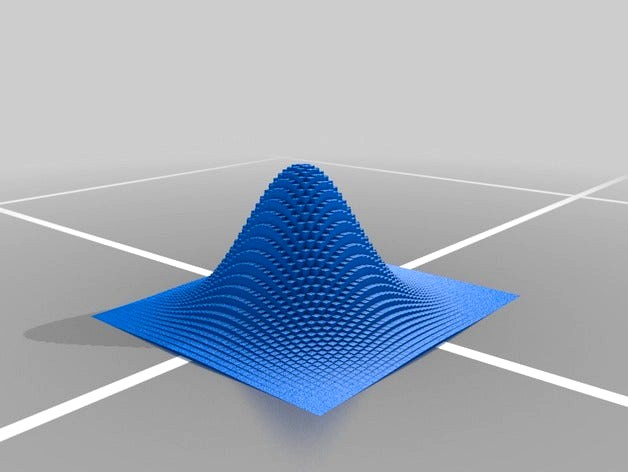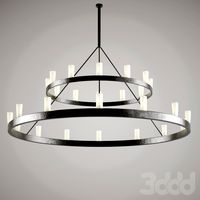Thingiverse

Double Integral Approximation by FormulaJockey
by Thingiverse
Last crawled date: 3 years ago
This was made at George Mason University for Math493: Mathematics Through 3D Printing, taught by Dr. Evelyn Sander.
Gives the double integral approximation for the function f(x,y) = 2*e^(-x^2-y^2), the Gaussian curve in 3 dimensions, using 100, 225, and 400 rectangular prisms, respectively on the interval [-2,2.5]x[-2,2]. The Mathematica code used to generate these models was based on Raouf Boules', Geoff Goodson's, Ohoe Kim's and Mike O'Leary's Calculus III Lab at Towson University, found here: http://www2.stetson.edu/~wmiles/coursedocs/Fall_05/MS_203/calc3labs/Calculus%20III%20-%20Lab%209.htm.
The integral approximator (code provided below) takes a function f on an interval [a1,b1]x[a2,b2] with n discretization points in both the x and y directions, therefore approximating the area under the function with n^2 rectangular prisms (cuboids in Mathematica). Just like in the 1-dimensional integral approximation methods, deltaX = (b1-a1)/n and deltaY = (b2-a2)/n. The x and y coordinates of the jth and kth rectangle are thus given by x_j = a1+deltaXj and y_k = a2+deltaYk.
In Mathematica, Cuboid[{lower corner (x,y,z), upper corner (x,y,z)]. Here the lower corner is given by (x_j, yk, 0), and the upper corner (x(j+1), y_(k+1), f(x_j, y_k)).
Suggestions: try playing around with the function, and changing the number of rectangles used.
Mathematica code:
RD[f, {a1, b1}, {a2, b2}, n] :=
Show[Table[
Graphics3D[Cuboid[{a1 + (b1 - a1)/nj, a2 + (b2 - a2)/nk, 0},
{a1 + (b1 - a1)/n(j + 1), a2 + (b2 - a2)/n(k + 1),
f[a1 + (b1 - a1)/nj, a2 + (b2 - a2)/nk]}]], {j, 0, n - 1}, {k,
0, n - 1}]]
Clear[f, x, y]
f[x, y] := 2*Exp[-x^2 - y^2]
print1 = RD[f, {-2, 2.5}, {-2, 2}, 10]
Export["filename.stl",print1]
Gives the double integral approximation for the function f(x,y) = 2*e^(-x^2-y^2), the Gaussian curve in 3 dimensions, using 100, 225, and 400 rectangular prisms, respectively on the interval [-2,2.5]x[-2,2]. The Mathematica code used to generate these models was based on Raouf Boules', Geoff Goodson's, Ohoe Kim's and Mike O'Leary's Calculus III Lab at Towson University, found here: http://www2.stetson.edu/~wmiles/coursedocs/Fall_05/MS_203/calc3labs/Calculus%20III%20-%20Lab%209.htm.
The integral approximator (code provided below) takes a function f on an interval [a1,b1]x[a2,b2] with n discretization points in both the x and y directions, therefore approximating the area under the function with n^2 rectangular prisms (cuboids in Mathematica). Just like in the 1-dimensional integral approximation methods, deltaX = (b1-a1)/n and deltaY = (b2-a2)/n. The x and y coordinates of the jth and kth rectangle are thus given by x_j = a1+deltaXj and y_k = a2+deltaYk.
In Mathematica, Cuboid[{lower corner (x,y,z), upper corner (x,y,z)]. Here the lower corner is given by (x_j, yk, 0), and the upper corner (x(j+1), y_(k+1), f(x_j, y_k)).
Suggestions: try playing around with the function, and changing the number of rectangles used.
Mathematica code:
RD[f, {a1, b1}, {a2, b2}, n] :=
Show[Table[
Graphics3D[Cuboid[{a1 + (b1 - a1)/nj, a2 + (b2 - a2)/nk, 0},
{a1 + (b1 - a1)/n(j + 1), a2 + (b2 - a2)/n(k + 1),
f[a1 + (b1 - a1)/nj, a2 + (b2 - a2)/nk]}]], {j, 0, n - 1}, {k,
0, n - 1}]]
Clear[f, x, y]
f[x, y] := 2*Exp[-x^2 - y^2]
print1 = RD[f, {-2, 2.5}, {-2, 2}, 10]
Export["filename.stl",print1]
Similar models
thingiverse
free

Taylor's Theorem by hdelgad2
.../10!…
note: for x^n/n! , where n equals a positive odd integer starting at n=1 will create an approximation to the sine function.
thingiverse
free

Math 2D functional surfaces by rossdl2
...eneral shape. the solid shapes printed out are a representation of the volume attained by integrating the functions over x and y.
thingiverse
free

Otto Araña - Otto Spider - Otto quad by rovimartinez
...pata b1
2 x pata b2
para mejorar su estética:
2 x carcasa motor a1
2 x carcasa motor a2
2 x carcasa motor b1
2 x carcasa motor b2
thingiverse
free

Multivariable Function Lesson by stepanp21
...ssroom" which will appear in primus.
the three functions used here are:
f(x,y) = x^2+y^2
f(x,y) = xy
f(x,y) = 2xe^(-x^2-y^2)
3dwarehouse
free

sketchy physics scale
...q r s t u v w x y z x a b c d e f g h i j k l m n o p q r s t u v w x y z x a b c d e f g h i j k l m n o p q r s t u v w x y z x
thingiverse
free

Discontinuity Surfaces
... 52 mm. printed with supports and raft.
see photos.
more of my mathematical models on cults:https://cults3d.com/en/users/abbymath
3dwarehouse
free

a simple sketchyphysics light show
...n o p q r s t u v w x y z a b c d e f g h i j k l m n o p q r s t u v w x y z a b c d e f g h i j k l m n o p q r s t u v w x y z
3dwarehouse
free

bearing tutorial
...n o p q r s t u v w x y z a b c d e f g h i j k l m n o p q r s t u v w x y z a b c d e f g h i j k l m n o p q r s t u v w x y z
thingiverse
free

color stierpinsky pyramid
...yramid
qb64 code:
screen 13
k = 2
for x = 0 to 84 step k
for y = 0 to 84 step k
line (x, y)-(x + k, y + k), x and y, bf
next
next
3dwarehouse
free

apc
...apc
3dwarehouse
1 2 3 4 5 6 7 8 9 0 q w e r t y u i o p a s d f g h j k l z x c v b n m
Formulajockey
thingiverse
free

Symmetry Group Tiles 1 by FormulaJockey
...es 2-space with 90 degree rotations (green circles) and perpendicular reflections (purple and yellow lines). created in openscad.
thingiverse
free

Pentagonal Tiling: Type 10 by FormulaJockey
...eant to look like a diamond--would be cool with 2 extruders to make the top a different color than the rest. created in openscad.
thingiverse
free

Aizawa Attractor by FormulaJockey
...00}, plotrange -> all,
plotstyle -> tube[.05, plotpoints -> 100], ticks -> none]
export["aizawa.stl", plot]
thingiverse
free

Thomas Cyclically Symmetric Attractor by FormulaJockey
...lotted the style in tubes of thickness 0.2. however, this thickness might be a little too thin, as the first print created broke.
Approximation
3d_export
$5

sockets
...sockets
3dexport
approximate number of polygons and vertexes
3d_export
$5

elite sockets
...elite sockets
3dexport
approximate number of polygons and vertexes
3d_export
$5

tweezers
...tweezers
3dexport
simple tweezers. approximately 10 cm length.
3d_export
$8

iron hook
...iron hook
3dexport
approximate measurements: 103 x 129.8 x 41.4 mm
3d_export
$5

industrial piece
...industrial piece
3dexport
approximate measurements: 88 x 40 x 52 mm
3d_export
$9

switch
...switch
3dexport
4-position switch approximate measurements: 28 x 15.7 x 10.9 mm
3d_export
$8

spiral bulb
...spiral bulb
3dexport
spiral light bulb approximate measurements: 40 x 135.1 x 40 mm
3d_export
$7

lamp base
...lamp base
3dexport
cable can be incorporated. approximate measurements: 127.9 x 52 x 100 mm
3d_export
$8

small led bulb
...small led bulb
3dexport
small bulb with details approximate measurements: 5 x 22.7 x 4.5 mm
3ddd
$1

Зеркало
...зеркало
3ddd
approximate dimensions:
- высота: 1800 mm
- ширина: 920 mm
- 3dmax2011.
- vray 2.00.02.
- *.fbx, *.obj.
Integral
3ddd
$1

+ Integration
...брики poggenpohl . в архиве сама кухня, кухонный остров и встроенная техника miele ( кофемашина, пароварка и микроволновая печь).
3d_export
$57

integral kitchen
...integral kitchen
3dexport
integral kitchen
3ddd
$1

Integrated bath
...integrated bath
3ddd
ванна , подиум
integrated acrylic bath
turbosquid
$15

Facades with integrated handle
...el facades with integrated handle for download as max and fbx on turbosquid: 3d models for games, architecture, videos. (1215935)
turbosquid
$19

Protective Barrier Integrator
...arrier integrator for download as max, obj, fbx, dae, and stl on turbosquid: 3d models for games, architecture, videos. (1507713)
turbosquid
$5

Cabinet with integrated freezer
... available on turbo squid, the world's leading provider of digital 3d models for visualization, films, television, and games.
3d_export
$5

Microchip PIC16F84 integrated 3D Model
...xport
circuit elements integrated pic16f84 microchip electronics
microchip pic16f84 integrated 3d model pluginmax 54764 3dexport
3d_export
$6

integrated signal lamp 20 specifications
...integrated signal lamp 20 specifications
3dexport
integrated signal lamp (20 specifications)
cg_studio
$55

Wolf Integrated Cooktops3d model
...d model
cgstudio
.dxf .max - wolf integrated cooktops 3d model, royalty free license available, instant download after purchase.
3ddd
$1

Cellu M6 Integral
...cellu m6 integral
3ddd
медицина
оборудование lpg для косметологических, медицинских и эстетических центров
Double
3ddd
free

Double
...double
3ddd
double , sicis
диван double от итальянской фабрики sicis next art
3d_ocean
$5

double stairs
...double stairs
3docean
double stairs
double stairs
3d_export
$5

double handle
...double handle
3dexport
double handle
3d_export
$5

double fastener
...double fastener
3dexport
double fastener
3ddd
$1

double bed
...double bed
3ddd
двуспальная
double bed
design_connected
free

Chair Double
...chair double
designconnected
free 3d model of chair double
3ddd
$1

Double Leaves
...double leaves
3ddd
double leaves
кресло китайской фабрики double leaves. vray, 3dmax 2013, гамма 2.2, текстуры в комплекте.
3ddd
free

Люстра Double
...люстра double
3ddd
double , david chipperfield
2004
размеры в архиве
3d_export
free

couch - double
...couch - double
3dexport
couch double with texture and .psd files for personal customization
3d_export
$10

double layer double speed chain
...d chain
3dexport
double layer speed chain (design very detailed) 3d model drawing model file reference using solidworks software
